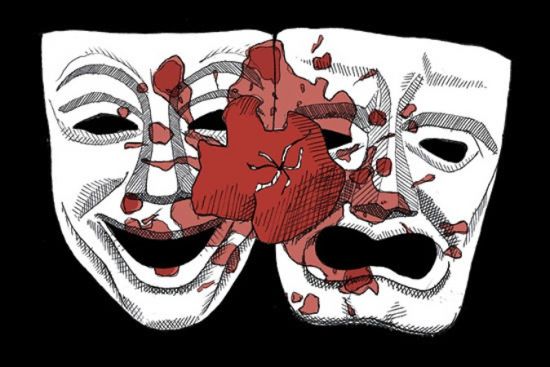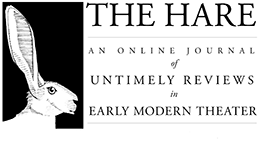
At some time in 1606 Prince Henry’s Men staged Thomas Dekker’s play The Whore of Babylon at the Fortune playhouse. It was apparently performed only once, and if we are to believe the author’s own account of it, the performance was a failure, something that Dekker clearly felt the need to explain away, for in the following year he published a quarto edition of his play with a preface, “Lectori,” in which he laid out what his intentions had been and what he thought had gone wrong. In fact “Lectori” is the sole source of information about this failure, and Dekker places the blame for it firmly at the door of the players. The “deformity” of the performance, he says, was the result of “bad handling” (39) by the players: “let the Poet set the note of his Nombers, even to Apollo’s owne lyre, the Player will have his own Crotchets, and sing false notes, in dispite of all the rules of Musick” (30-32). So insistent was he on blaming the players that he found two other metaphors to define their inadequacy: bad tailors ruining good cloth (32-3) and “ill nurses” spoiling newborn children (35).1
It needs to be noted that there are problems with accepting Dekker’s account of the shortcomings of the performance, for it appears that he was not present: “mine eare stood not within reach of their Larums” (27), he says. It is reasonable to ask why he did not attend what was obviously an important occasion for him, and (setting aside the possibility that he was ill) the most obvious explanation would seem to be that he had misgivings about the play even before it was staged. After all, his conception of the play was highly ambitious and he must have had a great deal of his own vanity vested in it, so the problem might well have been not so much that the performance was a failure, as that it disappointed him because it did not live up to his hopes. Even before the play was staged he seems to have felt some anxiety about the potential for the audience to fail to understand it, for in his Prologue, presumably written for the origin al staging, since it introduces the opening dumb show, he says:
wee present Matter above the vulgar Argument:
Yet drawne so lively, that the weakest eye,
Through those thin vailes we hang betweene your sight
And this our peice, may reach the mystery. (3-7)
It is all so well done, he insists, that even the dullest spectator will understand; but perhaps he was trying to deflect any potential objection to the opacity of his play by insisting on its clarity precisely because he had reservations about it.
Without question Dekker knew his way around a playhouse, and by 1606 he had had a long association with Henslowe’s companies and theaters. Henslowe bought a play from him for the Admiral’s Men as early as 1598, but in that year Francis Meres was already able to include him amongst those he considered “our best for tragedy.” Although he wrote a number of plays of which he was sole author, he collaborated with most of the major dramatists of the time, and Henslowe’s papers indicate that he had a hand in more than forty plays between 1598 and 1602. So the tradition that Dekker was a hack, possibly originating in Jonson’s characterization of him in Poetaster (1601) as a “dresser of plays about town,” is unfair. In fact, Dekker was a skilled writer with a seasoned professional’s understanding of how plays worked. It is worth asking, therefore what it was that he thought he was giving to the players in this particular case.
The Whore of Babylon is a glorification of Elizabeth I through a comprehensive account of the many Catholic plots against her during her reign and the apocalyptical defeat of Rome represented by the defeat of the Spanish Armada, and Dekker clearly intended it to be his masterpiece. It merges his position as a militant Protestant with his profound admiration of Elizabeth. In “Lectori” he describes it as a “Drammaticall Poem” (1), though this is a post-facto definition and might have occurred to him only in his self- exoneration; however the tension between the two elements of the phrase points to one potential source of its failure. His main “dramatical” model was the allegorical moral interlude, long obsolete (but understood to be associated with native ideological concerns), which gave him characters like Truth and Time and also precedents for the satirical voice of Plain Dealing. His main poetic model was The Faerie Queene, also celebratory of British-ness and British greatness, which offered him an apocalyptical structure and a form of romantic allegory through which he could present historical figures. At first glance Spenser’s poem, with its disguises and distorted reflections, the play of shifting identities that underlies its “dark conceit,” might also seem a useful theatrical model, but whereas the poem permits vast leisure for the reader to tease out its puzzles, similar puzzles fly past on the stage and can’t be recalled. So while informed spectators might immediately have seen through Campeius and Paridel as transparent masks for Campion and Parry, why should they have recognized Florimell as Leicester or Parthenophil as William Cecil (the latter an identification with which modern scholars have had some difficulty, and still insecure)? And how informed were the spectators at the Fortune about events twenty years in the past?2
Certainly, by the time he was preparing his quarto for publication Dekker seems to have recognized that the allegory was something of a problem, because he introduced into the text half-hearted marginal comments identifying some of these individuals. It is probable too that he revised the play, though it is not possible now for us to know how closely the quarto text represents the text that was performed. As an apology for the play, though, while insistently denying that the cause of the failed performance was in the text itself, “Lectori” is also defensive, informing the reader that Elizabeth’s reign was so glorious that “the Art of no pen is able to reach it” (13). In the second half of the preface Dekker begins by defending himself against those who have criticized him for distortions of chronology, but shifts immediately to his censure of the actors for crippling his play, effectively displacing a problem of the text onto the performance. But whether or not the staging of The Whore of Babylon was actually as inadequate as Dekker says it was, we can see in his text things that might have caused problems for Prince Henry’s Men.
We do not know much about the audience at the Fortune, but they do seem to have liked a bit of spectacle. Dekker tried to give them this by cramming the stage with actors. We do not know much about the size of the acting company either, but it appears that in 1604 the Prince’s Men had nine principals. The dramatis personae of the play lists upwards of twenty-five named or identified characters, which must have put tremendous pressure on the company with the need to double many roles. Beyond this, the play demands many players for supernumerary roles. The opening dumb show establishes these numbers; although it is difficult to estimate how many performers must have been involved, apart from the Prologue, Time, and Truth, there seems to be need for a minimum of twelve actors to follow the hearse of the queen. After a quick change of costume for Time and Truth these are joined by Titania accompanied by a retinue “fitting her estate” (20-1), so presumably of at least the same size. This suggests a total number of not fewer than thirty, and a very large bill for hired men. Furthermore, if we assume that most of the major doubled roles went to leading players this raises more questions: most scenes in the play take place either in Babylon or in Titania’s court; some characters appear in both locations, but generally they remain in one place. This means that there must have been some doubling between “good” and “bad” characters, increasing the potential for both aesthetic and moral confusion.
Another source of spectacle is the series of five dumb shows. Dekker clearly intended to provide variety with these, but two of them (the opening show and that in 4.1) need such lengthy explication that their theatrical effect is undermined. The dumb show in 1.2 in which the three Kings come in disguise to Titania is presented as a masque, and is used to discredit the Kings’ duplicity, but has the corollary antitheatrical effect (intentional?) of discrediting masque performance. The final dumb show stages the Whore on her scarlet-coloured seven-headed beast. This beast is described on three occasions, and it must have put the property-makers to the test. Henslowe’s inventory of March 1598 of properties available to the Admiral’s Men lists amongst them a dragon, a lion, and a horse with his legs, so a beast would not, perhaps, have been beyond the makers’ capabilities, but it is not an object that could have been used on many other occasions unless it were a modified dragon.
It is difficult, given the ambiguities (or confusions) of the text to decide how this beast would have been presented, whether as a terrifying threat to Titania’s realm or as a satirically comic object. This underlines a problem that some critics have recognized, of there being a disabling instability in the moral-allegorical structure that leads potentially to dramatic incoherence. Dekker made a fundamental error in allowing the play’s villains, those gathered in the court of the Empress of Babylon, to have the opening scene, for this gives them the initiative in generating potential sympathy by complaining about the slanders of their opponents, and it leaves Titania and her court largely to echo the same kind of complaint. One could argue that Dekker is presenting a subtle relativistic account of conflicting versions of truth, but of course he and his audience were predisposed to favoring Titania’s court, so he unnecessarily muddies the situation. Similarly, his decision to use Plain Dealing as a voice to satirize the vices of Titania’s subjects as well as those of the Empress also undermines the idealization of Titania’s position.
Dekker’s dramatical poem has many virtues. It has some excellent writing and some moments of very complex interaction. It is not in the same league as The Faerie Queene, but it offers some of the same pleasures. Unfortunately these need the kind of leisurely inspection that is not available in a dramatic presentation, and it is, finally, more poem than drama. Combining archaism with bold experimentation, it incorporates an astonishing range of theatrical forms and methods. It would be gratifying to believe that this ambitious spectacle did actually work at the Fortune, but it is difficult to see how any company at the time could have given it effective staging. So perhaps in turning his play into a work Dekker was really doing the best thing for it, allowing the reader to understand what the spectator quite probably could not.
- 1. All quotations are from the Camrbidge edition of Dekker, ed. Fredson Bowers, Vol. 2 (1955).
- 2. Julia Gasper’s book on Dekker (Oxford: Clarendon, 1990), has a lengthy chapter on the play, and on Dekker’s militant Protestantism and love for Elizabeth, but does not address this question of audience memory.
